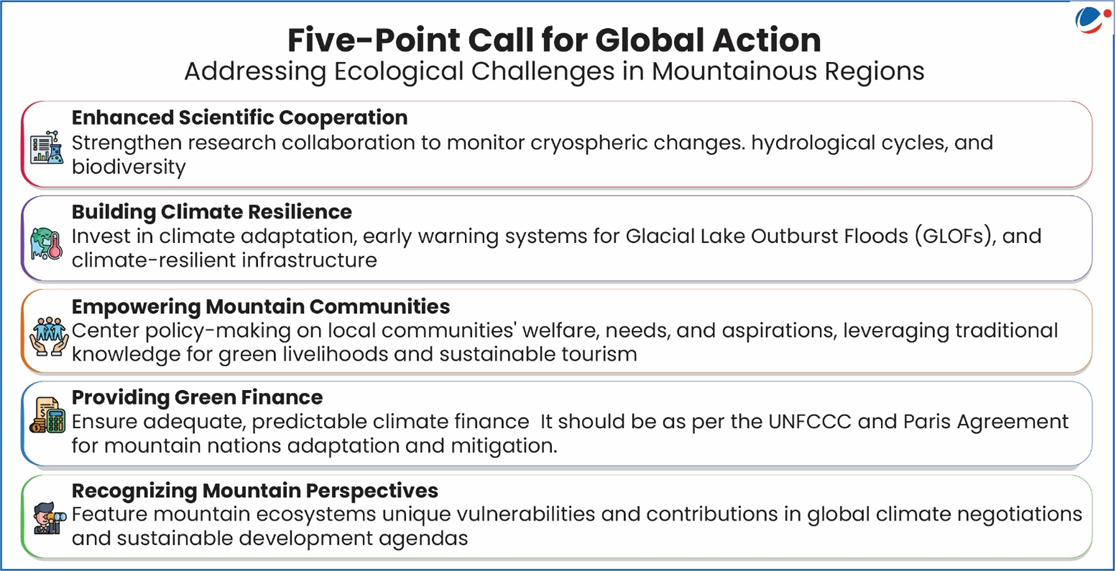Why in the News?
Union Minister for Environment, Forest and Climate Change, represented India at the inaugural session of the Sagarmatha Sambaad in Kathmandu, Nepal.
More on the News
- Sagarmatha Sambaad: It is a multi-stakeholder dialogue forum committed to deliberating on the most prominent issues of global, regional and national significance.
- Theme of the Summit: 'Climate Change, Mountains, and the Future of Humanity'.
- India outlined a five-point call for global action to address ecological challenges in mountainous regions (See infographic).

Physiography of the Himalayan Mountain System
- It is the youngest and highest fold mountain range in the world.
- The Himalayan Mountain System extends across five countries: India, Nepal, Bhutan, China, and Pakistan.
- Geological Formation: Formed as a result of the collision between the Indian Plate and the Eurasian Plate around 50 million years ago.
- Important glaciers: Gangotri Glacier (Bhagirathi), Bandar Poonch Glacier (Yamunotri Glacier at Bandarpuch peak), Alakapuri Glacier (Alaknanda), Sumeru Glacier (Mandakini), Bara Shigiri Glacier (Chenab), Zemu Glacier (Teesta),etc.
- The Indian Himalayan System: Spread across 13 states and UTs Jammu and Kashmir, Ladakh, Uttarakhand, Himachal Pradesh, Arunachal Pradesh, Manipur, Meghalaya, Mizoram, Nagaland, Sikkim, Tripura, Assam and West Bengal), stretching across 2500 km.
- Vegetation: The vegetation ranges from tropical forests (in the foothills) to temperate forests (in the middle ranges) to alpine meadows (at higher altitudes).
Ecological Significance of the Himalayan Mountain System
- Biodiversity of the Himalayan Hotspot (A region rich in biodiversity)
- Biodiversity Hotspots: It covers two biodiversity hotspots out of four Indian Biodiversity Hotspots, i.e. Himalaya Hotspot and the Indo-Burma Hotspot.
- High Species Richness and Endemism in the Himalayas: The region hosts 32% endemic plant species and unique fauna like the snow leopard, red panda, and Himalayan Blue Sheep (Bharal).
- The Himalayan Cryosphere (also called Earth's Third Pole)
- Glacial Significance: The Himalayas contain the world's 3rd largest glacial reserve (after the Arctic and Antarctic).
- The Himalayas are the Water Tower of Asia: The Himalayas feed 10 major rivers (e.g., Ganges, Brahmaputra, Indus, and Yangtze), that provide freshwater to ~1.3 billion people across the region.
- Climate Regulation and Carbon Sequestration:
- Monsoon Regulation: Temperature difference between Himalayan glaciers & Indian Ocean pulls South West monsoon during summers.
- Carbon sink: Himalayan forests store 5.4 billion tonnes of carbon.
- Albedo Feedback: The Himalayas (having a high albedo due to ice and snow cover), play a significant role in the Earth's albedo, which is the measure of how much sunlight is reflected by a surface.
- Economic Services of the Himalayas
- Fiber and Timber Production: E.g., Himalayan nettle provides eco-friendly fibers, while oak trees offer timber. Gucchi mushroom is a prized wild mushroom found in the higher reaches of Himalayas.
- Rising Tourism: By 2025, it is projected that 240 million tourists will visit the hill States every year.
Threats to the Ecosystem of the Himalayan Mountain System
- Deforestation and Habitat Loss: Himalayan states reported an overall loss of 1,072 sq km of forest cover between 2019 and 2021.
- Loss of Biodiversity: Endangered species like the snow leopard, red panda, and Himalayan musk deer face habitat destruction.
- Accelerated Glacial Retreat and Hydrological Disruption: E.g., the Gangotri glacier in the Uttarakhand Himalaya retreated by 1,700 metres between 1935 and 2022.
- Glacier retreat also leads to the expansion of glacial lakes, which increases the risk of Glacial Lake Outburst Floods (GLOFs). E.g., the 2013 Kedarnath disaster in Uttarakhand.
- Impact of Climate Change on the Himalayan Region:
- 90% of the Himalayan region will experience drought lasting over a year if global temperatures rise by 3°C.
- Threat to Water Resources: The springs in the Indian Himalayan region, vital for 50 million people, are drying up or becoming seasonal due to erratic rainfall and ecological degradation.
- In 2018, Niti Aayog warned that half the region's springs face depletion, impacting river hydrology.
- The Himalayas are warming 2-5 times faster than the global average, disrupting biodiversity in the region.
- Unsustainable Tourism: Unchecked tourism and development, without carrying capacity studies, are triggering severe geological hazards, including landslides and land subsidence.
- E.g., the sinking of Joshimath due to excessive construction for tourism infrastructure.
- Uncontrolled Hydroelectric Development: Over 115 large hydroelectric projects in the Indus basin, mainly in Himachal Pradesh and Jammu & Kashmir, threaten river ecosystems and the environment.
Initiatives to Protect the Ecosystem of the Himalayan Mountain System | |
India's Initiatives
| Global Initiatives
|
Conclusion
The Indian Himalayas hold geopolitical, cultural as well as environmental significance. However, habitat loss from land-use changes, illegal wildlife trade, forest fires, and rising anthropogenic pressures continues to threaten this fragile biodiversity hotspot, underscoring the need for stronger conservation efforts.



